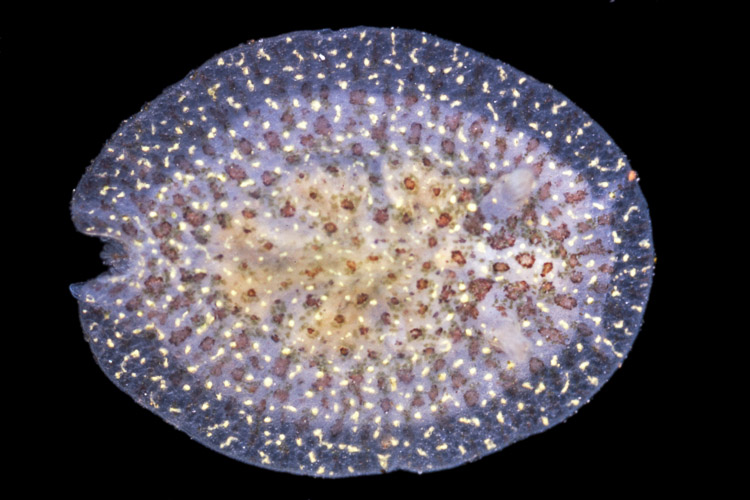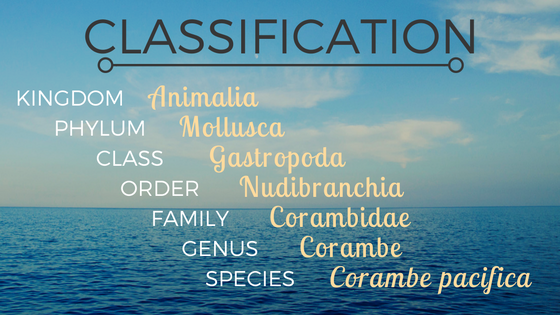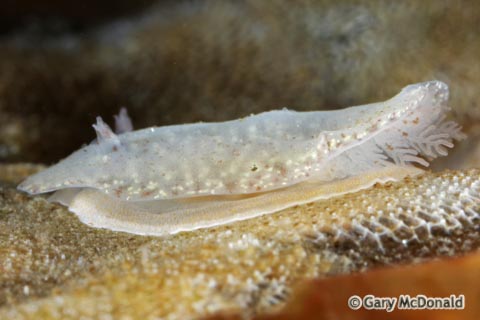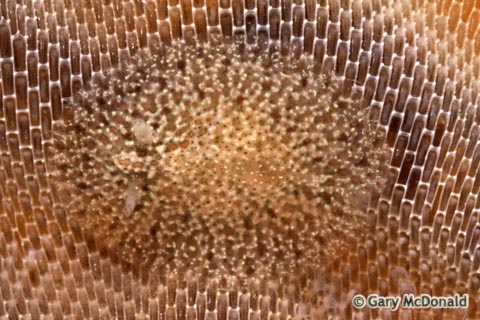Corambe pacifica on a microscope slide. Photo courtesy of Gary McDonald.
Sink or swim
The frost-spot corambe belongs to a group molluscs called nudibranchs (pronounced NEW-dih-branks, meaning naked lungs or gills), also known as sea slugs. Like most nudibranchs, C. pacifica begins its life with a coiled snail-like shell in a swimming larval stage. The shell is then shed as the larval nudibranch grows into its adult form.
Keeping up appearances
Frost spot adults grow to a small 10 mm in length and have a flat disc-like body. They have a wide fleshy skirt called a mantle with a notch in the middle posterior (rear) end. Feathery gills used for breathing protrude from under the notch. The gills are a series of simple finger-like plumes which range in number (6 to 14), depending on the animal’s age. Feathery gills are visible beneath the mantle, and the foot can easily be seen with its distinct white rim. Photo courtesy of Gary McDonald.
Almost all molluscs (with the exception of octopus/squids) have a flat muscular organ called a foot that is used for crawling. The frost-spot corambe's foot is narrow and translucent with a white line running around the outer edge. LEFT: An exposed rhinophore. RIGHT: A rhinophore partially covered by the protective sheath. Photos courtesy of Gary McDonald.
Sitting on top of the animal’s head are two rhinophores, similar to an insect’s antennae. The frost spot has grooved rhinophores that function as sensory organs to detect food and can retract inside a trumpet-shaped sheath for protection from nibbling predators.
Hide and seek
The frost spot, a master of camouflage, has markings that are designed to perfectly match its habitat, making it almost invisible to potential predators. In this case, the habitat being mimicked is Membranipora, a particular bryozoan on which it feeds exclusively. Bryozoans are colonial animals that grow on hard surfaces. Each bryozoan colony is made up of many little “chambers,” each containing an individual animal that makes a tasty snack for the sea slug to slurp up. Can you spot Corambe pacifica hiding in its habitat on a Membranipora bryozoan colony? Photo courtesy of Gary McDonald.
The frost spot is moderately common in Puget Sound, but it is not often collected during sediment monitoring because of the location of its preferred habitat. Membranipora is found encrusting kelp blades, seagrasses, and other hard surfaces that we don’t often encounter with our sampling equipment.
Eggs over easy
If you can’t spot the slug itself, you might be able to spot its bright white egg mass. The frost-spot corambe lays its eggs on the bryozoan in a spiral ribbon that looks like a cinnamon roll.
Why the spiral shape, you ask? The spiral gives the eggs a better shot at survival by keeping them close together but still with plenty of space for oxygen to move between them. Corambe pacifica deposits its eggs in a spiral shape. Photo courtesy of Gary McDonald.
Critter of the Month
Our benthic taxonomists, Dany and Angela, are scientists who identify and count the benthic (sediment-dwelling) organisms in our samples as part of our Marine Sediment Monitoring Program. We track the numbers and types of species we see in order to understand the health of Puget Sound and detect changes over time.
Dany and Angela share their discoveries by bringing us a Benthic Critter of the Month. These posts will give you a peek into the life of Puget Sound’s least-known inhabitants. We’ll share details on identification, habitat, life history, and the role each critter plays in the sediment community. Can't get enough benthos? See photos from our Eyes Under Puget Sound collection on Flickr.







